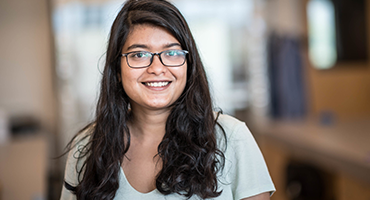PHAS graduate student feature: Samikshya Sahu

“The most impactful thing in physics is materials science. Every big advance – in aerospace engineering, in computing – it all depends on materials, and the properties of materials influence where science is able to go and what we are able to create,” said Samikshya Sahu, a PhD student in Alannah Hallas‘ lab. “Here at the Stewart Blusson Quantum Matter Insitute, with Alannah, every step of that process is supported, and I really wanted to be at a place where that kind of ambitious, interdisciplinary work was taking place.”
Sahu is a PhD student who came to the Stewart Blusson Quantum Matter Institute (Blusson QMI) for the research milieu, the collaborative, interdisciplinary environment, and the opportunity to pursue research questions with real-world implications. Following the completion of her undergraduate degree at the Indian Institute of Science Education and Research, Sahu came to UBC specifically to work at the Blusson QMI, with Hallas, Assistant Professor in the Department of Physics and Astronomy, in particular. She is currently studying a series of intermetallic quantum materials, with a focus on design, crystal synthesis, and the characterization of exotic states of matter.
“Experimental work is a bit of an adventure,” said Sahu. “In Alannah’s lab, we are not just working with a single material; we are playing around with lots of combinations of materials, studying them, and developing new materials with interesting new properties. We are literally working with hundreds of potential combinations and properties, creating systems that have evolved beyond the basic properties of common materials.”
Once a material has been created, characterization follows. This includes a variety of measurements like X-ray diffraction and structural refinement, transport properties, magnetization curves, heat capacity, neutron scattering, muon spectroscopy, etc, as per the material requirement. For one of her projects Sahu is also collaborating with Sarah Burke and Douglas Bonn’s teams, including PhD student Dong Chen, to cleave the materials her team has grown to study their topography and band structure using Scanning Tunneling Microscopy, which is a technique that uses quantum tunnelling of electrons to image material surfaces at their atomic level.
“In this era of science, there is no progress without collaboration,” she says.
“I enjoy how connected the research teams are at Blusson QMI, and how research in one lab can motivate research in another,” said Sahu. “A highlight for me has been when we are growing a material that is very easily exfoliable into layers, that we can connect with other teams to use techniques like scanning tunneling microscopy or angle-resolved photo-emission spectroscopy to probe these materials. It’s all here.”
In addition to the collaborative nature of the work she does, Sahu also appreciates the opportunities for mentorship, and the leadership and expertise of the female faculty at Blusson QMI.
“This is a place where women lift each other up,” she said. “When you see women leading labs and teaching hard topics and doing it well, it is inspiring – it’s easier to see yourself succeeding when you see other women succeeding.”
Someone who stands out for Sahu is Mona Berciu, who led PHYS 502, a course on condensed matter physics.
“Mona taught us so thoroughly! She would spend hours on tutorials, and seemed to truly love the topic. There are people who you can just see that they love what they do, and she is one of them,” said Sahu.
“Blusson QMI is an unusual place. When I was looking at graduate programs, there are so many to choose from but very few that offer the unique environment that we have here,” said Sahu. “There is abundance here – of resources, of support; I am grateful to be studying here, working with Alannah who has been truly remarkable and insightful as a mentor and so many other researchers. We really are doing work that will have an impact in the relatively near future. A quantum reality is not 30, 40 years away anymore, and I’m so excited about that.”
A version of this story originally appeared on the Stewart Blusson Quantum Matter Institute website.
Know a PHAS undergraduate or graduate student we could feature? Let us know - contact Theresa Liao (PHAS Communications Coordinator) at communications@phas.ubc.ca.